 In my opinion, a drift of grape hyacinths in full bloom is one of spring’s crowning moments. They may be small, but they pack a big visual punch. The muscari group is one of the most charming and most reliable of all of the small spring flowering bulbs. The tiny corm, planted only 3″ below the surface of the soil in the fall, will give rise to a pair of thin strappy white striped leaves, and a flowering raceme the most brilliant shade of cobalt blue. That blue makes a spring garden worth growing.
In my opinion, a drift of grape hyacinths in full bloom is one of spring’s crowning moments. They may be small, but they pack a big visual punch. The muscari group is one of the most charming and most reliable of all of the small spring flowering bulbs. The tiny corm, planted only 3″ below the surface of the soil in the fall, will give rise to a pair of thin strappy white striped leaves, and a flowering raceme the most brilliant shade of cobalt blue. That blue makes a spring garden worth growing.
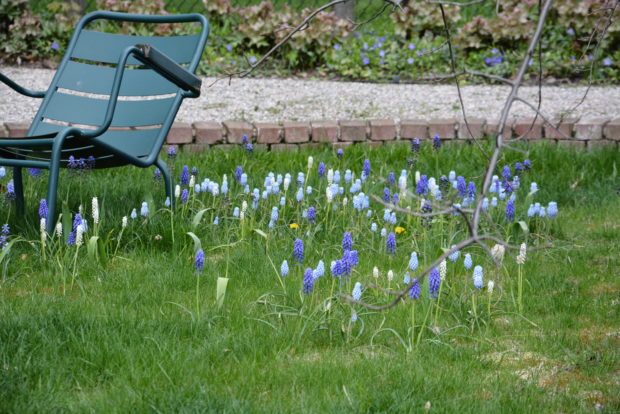 From my favorite on line horticultural reference for the Midwest, the Missouri Botanic Garden Plant Finder, I read the following:
From my favorite on line horticultural reference for the Midwest, the Missouri Botanic Garden Plant Finder, I read the following:
“Muscari armeniacum, commonly called grape hyacinth, is an early spring-blooming bulbous perennial that is native to southeastern Europe (including Armenia). It features conical racemes of slightly fragrant, tightly packed, deep violet blue, urn-shaped flowers atop scapes rising to 8” tall in early spring. Each bulb produces 1-3 scapes with 20-40 flowers per scape. Each flower has a thin white line around the rim. Dense inflorescence purportedly resembles an elongated, upside-down bunch of grapes, hence the common name. Scapes rise up from somewhat floppy clumps of narrow, fleshy, basal, green leaves (to 12” long) that appear in autumn and live through the cold St. Louis winter to spring when the plants flower.”
This description tells me that Muscari will grow well in my garden, but I would like to add that they are simple to plant. All you need is some decent friable soil, and a finger to push them below ground. I have seen corms left laying on the surface send a few roots into the soil, and bloom on their sides the following spring. They are willing.
 Grape hyacinths will come up and thrive just about anywhere you plant them. I would avoid soggy soil that would rot the corms, and dark places fit only for ferns. They come up through a lawn without complaint. They are incredibly hardy. I have never done anything to mine, except plant and enjoy. They are persistent year after year, and can make substantial clumps. The only difficulty? You have to buy and plant them in the fall. Preferably in 50’s or 100’s. If you are willing and able, they will be too.
Grape hyacinths will come up and thrive just about anywhere you plant them. I would avoid soggy soil that would rot the corms, and dark places fit only for ferns. They come up through a lawn without complaint. They are incredibly hardy. I have never done anything to mine, except plant and enjoy. They are persistent year after year, and can make substantial clumps. The only difficulty? You have to buy and plant them in the fall. Preferably in 50’s or 100’s. If you are willing and able, they will be too.
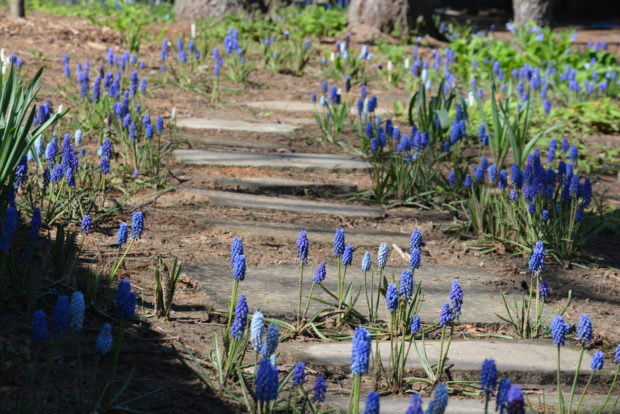 A new landscape project I am about to install involves the installation of a fairly large partial shade garden. My clients are very fond of blue flowering plants, and especially blue spring flowering bulbs. The rustic stone walk was finished in late October. The coast was clear to plant bulbs, which we did fairly late in November. It was cold, but as long as the ground is not frozen, spring flowering bulbs can be planted. Since the planting would be late, we stored the bulbs in a cool place, so they would not suffer from being out of the ground so long. Muscari cultivars seldom grow talled than 8″, so planting them near the walk made sense.
A new landscape project I am about to install involves the installation of a fairly large partial shade garden. My clients are very fond of blue flowering plants, and especially blue spring flowering bulbs. The rustic stone walk was finished in late October. The coast was clear to plant bulbs, which we did fairly late in November. It was cold, but as long as the ground is not frozen, spring flowering bulbs can be planted. Since the planting would be late, we stored the bulbs in a cool place, so they would not suffer from being out of the ground so long. Muscari cultivars seldom grow talled than 8″, so planting them near the walk made sense.
 We planted a variety of muscari cultivars, all the the blue and white range. We planted the tried and true muscari armeniacum, and Blue Magic, Atlantic muscari, Magical Mixture, and superstar. Lots of cobalt blue, light blue, with a smattering of white. We also planted several types of camassia, and chionodoxa forbesii Blue Giant, to extend the blue spring bloom period. Later yet, there will be some smaller growing alliums. These muscari blooming make a quite a statement, even though they are blooming in an ocean of bare dirt.
We planted a variety of muscari cultivars, all the the blue and white range. We planted the tried and true muscari armeniacum, and Blue Magic, Atlantic muscari, Magical Mixture, and superstar. Lots of cobalt blue, light blue, with a smattering of white. We also planted several types of camassia, and chionodoxa forbesii Blue Giant, to extend the blue spring bloom period. Later yet, there will be some smaller growing alliums. These muscari blooming make a quite a statement, even though they are blooming in an ocean of bare dirt.
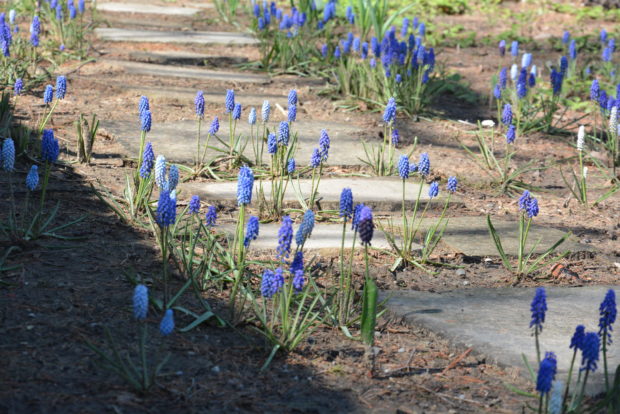 The planting of this woodland garden got a head start last fall. The locations of these bulbs will direct the height and bloom season of what I plant with them. We will plant sweet woodriff and European ginger. Were the soil not so sandy, I would plant forget me nots. I will plant more Virginia bluebells to the patch that is existing, Jack in the pulpit, Dutchman’s britches, anemone sylvestris, campanula porscharskyana, lamium white nancy, and so on.
The planting of this woodland garden got a head start last fall. The locations of these bulbs will direct the height and bloom season of what I plant with them. We will plant sweet woodriff and European ginger. Were the soil not so sandy, I would plant forget me nots. I will plant more Virginia bluebells to the patch that is existing, Jack in the pulpit, Dutchman’s britches, anemone sylvestris, campanula porscharskyana, lamium white nancy, and so on.
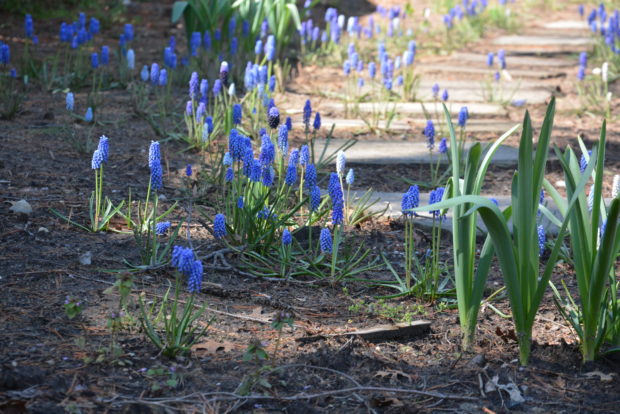 We also have planned for a few Venus dogwoods in the sunniest places, a few witch hazel, and a few Canadian hemlocks. Blue leaved hostas, big and small. If we plant any astilbe, it will be a loose and airy growing version. A stand of goatsbeard is a good choice for the back of the shady border. Like snakeroot, they take some time to establish and grow – but they are well worth the trouble.
We also have planned for a few Venus dogwoods in the sunniest places, a few witch hazel, and a few Canadian hemlocks. Blue leaved hostas, big and small. If we plant any astilbe, it will be a loose and airy growing version. A stand of goatsbeard is a good choice for the back of the shady border. Like snakeroot, they take some time to establish and grow – but they are well worth the trouble.
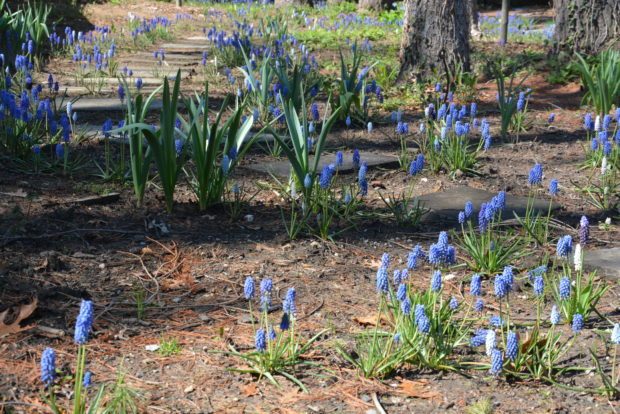 Right now, this is a garden of possibilities. What a pleasure to be at that point, in early spring. If you are planning a garden in our zone right now, check out the Missouri Botanic Gardens opinion about your choices. And leave some spaces and places for grape hyacinths.
Right now, this is a garden of possibilities. What a pleasure to be at that point, in early spring. If you are planning a garden in our zone right now, check out the Missouri Botanic Gardens opinion about your choices. And leave some spaces and places for grape hyacinths.
Blue, blue, my love is blue…. and with you at the helm, Deborah, this landscape has only more loveliness to look forward to. Second only to dogs in the garden, my favorite posts are when you show landscapes you are working on. I too love the blue and white of spring, having planted scilla siberica, chionodoxa, ipheon, and of course the muscari (esp light blue Valerie Finnis) together with lots of white daffs. (Take that, CT deer!) . All these beautiful blue and white landscapes need are a temporary instillation of a few blue and white Chinese porcelains nestled amongst them just for fun…. and then in a few weeks, on to the next beauty of nature!
Dear Marguerite, this landscape is underway. My clients are great. They are confident enough to trust me, and they are confident enough in themselves to take the time to see how things will unfold. That blue river following the path enchants the both of us. all the best, Deborah
I was wandering alone through Cetinje, the ancient, former-capital of Montenegro one early spring day a few years ago. It was grey, cold and felt abandoned. But there in a park of huge old trees near tumbled stones of old ruins was a vast carpet of grape hyacinths. They must have been planted decades, if not longer, in the past, and naturalized and spread and spread.
You hear that they will naturalize, but I never want to wait, so I just plant hundreds under trees wherever I live. This was proof it really does occur, and it was magical.
Dear Anne, many thanks for your letter. You wrote about grape hyacinths better than I did – thanks again. I love them so. best, Deborah
I love that day in spring when the lawns turn blue.
Dear Ellen, I am right with you. Blue lawns, rivers of blue, blocks of blue-spring blue is the best. thanks for writing, Deborah
I can’t wait to see some pictures of the finished project. Your ability to place pictures in my mind with only descriptions astounds me. Thank you for all you do, hope you have a beautiful day.
Dear Shelley, I am so looking forward to this project.It has been 18 months in the making. I could not be happier, given this project, and this moment. best, Deborah
Hi Deborah – the grape hyacinths are beautiful, but what about all those leaves that are around all year? That’s the reason I stay away from them . . . also, once you’ve planted grape hyacinths, you’ll never get rid of them? What about scilla instead? They come up in spring, provide a similar color, self-seed and spread, but their leaves disappear after a while and they don’t shoot up again later in the season. Thanks!
Dear Mike, the foliage of grape hyacinths disappears after they bloom. But the bulbs do send up fresh foliage in the fall. In an informal garden, that fall foliage is not to my eye a problem. That foliage is fresh and green-I do not mind it. I am also very fond of scilla. But I do not see them as a substitute for grape hyacinth. I see them as an addition to the spring garden. This is just me talking, but I would never want to get rid of my grape hyacinths. They enchant me, wherever they appear. What enchants a gardener is a personal preference. I do not in any way suggest that what I like in a garden is a call to action. No gardener is obliged to like what I like. I just write about what I like, and the reasons why. all the best to you, Deborah
Deborah, here’s another possibility both you and Mike might entertain, possibly for different reasons: I have alternated Muscari armeniacum in my flower beds with Muscari paradoxum. The paradoxum variety is slightly darker blue, almost navy in full sun, and the leaves are a bit wider and more substantial, more like an allium or leucojum leaf and less grassy than armeniacum. The paradoxum are a little bit slower to appear in spring, so that they overlap the armeniacum bloom period, and stay a little after the armeniacum begin to dry up. But the big plus is that paradoxum do not send up leaves in the fall. That might mean that they would be less prone to deer destruction when deer are hungriest, storing up their fat supplies for winter, and the leaves would disappear after spring bloom time like most spring ephemerals for a neater bed appearance. I live in the country in mid-Michigan where deer travel through our yard of several acres regularly, but I have never seen any evidence of deer nibbling any of my grape hyacinth varieties. In fact, there are a couple of very old plants along the property line, bulbs or great-grandchildren of bulbs that were planted many years ago by a previous property owner, long before my house was even built. Every spring in the woods along the edge, one daffodil and a few grape hyacinths appear there, and the deer have never bothered them, even though they are directly along the route the deer usually take to pass through our yard. (A stream runs through our property, so they come to drink there regularly.) However, I do know from experience that as deer populations grow, deer become bolder about experimenting with garden plants. When and where they are hungry enough, they are willing to eat nearly any plant, whether considered “deer resistant, deer proof” or not. The deer around here are most likely to do damage to perennials, trees, or shrubs in March, when they are most starved after the winter (This is also when most deer die, NOT in the deepest cold, dead of winter), and when the grasses and other favorite browse plants have not yet begun to leaf out in full force. And I know that deer pressure has grown very intense in suburban areas in many states, particularly in both southeastern and southwestern Michigan. And to think that at one point in my own adult lifetime, whitetail populations in Michigan had reached such low levels that Michigan actually imported deer from New York state to bring back numbers to satisfy hunters! One program to prevent extinction that most drivers and gardeners in Michigan would agree worked a little TOO well!
Dear Dianne, thank you for this detailed letter. Your personal experience is information that would not be available to anyone unless you choose to write about it. I appreciate that you did. I have had a chance to read about this variety-I had never head of it before. best, Deborah
A warning to those who have deer. Grape hyacynths send up new leaves in the Fall. Over the winter the deer will eat them which greatly weakens the bulbs. In an area I have not fenced the hundreds of bulbs have disappeared.
Dear Linda, I am so surprised that deer would eat the fall foliage from grape hyacinths. I have never seen this, even in client gardens with a resident deer population. But I will take your word for it. In my opinion, deer populations that have multiplied like crazy means there is more intense competition amongst them for food. Even food that they would not ordinarily eat. The destruction of gardens by deer is heartbreaking.
I have had the same experience, Linda. This is particularly disappointing since I planted a magical s-curve of muscari sweeping across the lawn under crabapple trees. It was fine for a year or two but the deer have multiplied and developed a fondness for muscari foliage. I’m considering replacing the bulbs with daffodils which the deer ignore. It won’t give the same effect but the change may be an improvement. Or so I’m hoping.
This is a wonderful post…I love the path with the muscari…I have had a few drifts spring up over the last two seasons between the ivy border…not at sure at first, but I am learning to love it…also, it seems to be popping out in our woods here and there….we live on the Niagara Escarpment, I garden in the shade, so, all your suggestions for companion plants is noted and appreciated…so many are already established here in the garden and woodlands…still planning a trip to Detroit Iron Works in June!
Dear Deborah,
Another love we share – grape hyacinth! Big beautiful swaths of them. I don’t see them around here so they had not occurred to me while planning our shade/semi-shade landscape. They are versatile enough that I had a beautiful patch of them in my very hot southern exposure, full sun Texas yard. Now I need to plant them here! This entire post is very inspirational for me and enjoyable writing. Nice link as well. Have a great Spring!
My best to you! Eileen